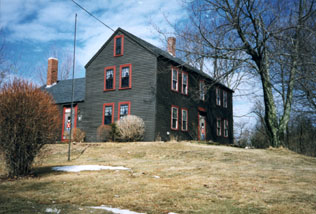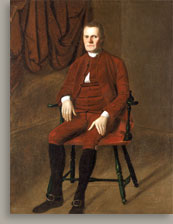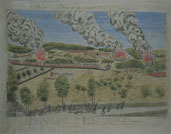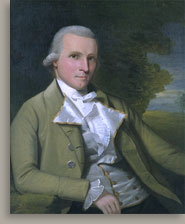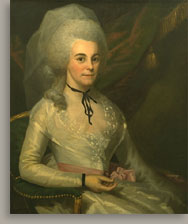| Ralph Earl Born Leicester or Shrewsbury, Mass., May 11, 1751. Died Bolton, Conn., August 16, 1801. Ralph Earl was an itinerant artist who painted at least 183 portraits and six landscapes, including a panorama of Niagara Falls.1 His career can be divided into three periods: an early phase, from which just a handful of attributed and lost works are known; seven years in England during and just after the American Revolution; and sixteen final, highly productive years in America. While in England, Earl plied his trade in the provinces, studied in London with Benjamin West and exhibited at the Royal Academy. There his drawing improved considerably, his compositions became more complex, and his use of color became more sophisticated. He also experimented in England with different formats and introduced landscapes and complex interiors into the backgrounds of his portraits. These would become signature features of his later American work. The final period of his life included three years’ residence in New York City and thirteen years as a traveling artist in Connecticut, New York, Massachusetts, and Vermont. Earl is best recognized for portraits that include landscape settings specifically related to the lives of his sitters or interiors decorated with furniture, professional attributes, books, and other possessions that help to individualize his patrons’ identities. The artist’s brother James Earl (1761–1796), son Ralph E. W. Earl (1785/88–1838), and nephew Augustus Earl (1793–1838) were all artists. His life story—colored by his loyalty to the British Crown during the Revolution, two overlapping marriages, more than a year in debtors—prison, and a death hastened by alcoholism—reads like one of the morality tale-novels written during the period.
The fact that Earl, who was loyal to the Crown, could be commissioned to portray an important patriot such as Sherman at the moment when the American Revolution was erupting suggests that life in that time and place was especially complex. This complexity is further illustrated by a nearly contemporaneous episode in the artist’s life. Earl’s father refused a commission in the British Army, instead earning a captaincy in the local militia.7 Ralph Earl, however, refused to serve and narrowly escaped prison for taking that stance as well as for his unwillingness to pay taxes in support of the American uprising.8 Yet at the same time, Earl probably created preparatory drawings for four prints depicting the Battle of Lexington and Concord that propagandized on behalf of the Revolution (fig. 3). 9 These engravings were executed by Amos Doolittle (1754–1832) and first advertised for sale in New Haven on December 13, 1775—a month before Earl was named for leaving the colony without paying taxes.10 This printmaking project is significant not only because the resulting engravings express political beliefs diametrically opposed to Earl’s own position but also because they reflect Earl’s early interest in creating specific landscape views. Later, landscape would figure importantly in his portraits and would serve as the subject of other works. Earl’s wife joined him in New Haven in November 1776, and they lived there until May 1777. This six-month period, Sarah later attested, "was all the time we kept house together."11 Because of his Loyalist sympathies, the artist came under increasing pressure to leave his adopted city. In April 1777 Earl and several other men had been characterized in the Connecticut Journal as being "friends of George the third and would not take up arms against him or his troops." Their behavior was further described as a "glaring instance of treason," and a petition signed by fifty people demanded that action against them be taken.12 Earl eluded punishment with the assistance of General John Burgoyne’s quartermaster general, John Money (1752–1817), who "had the goodness to disguise him as a Servant and bring him from Providence to Newport in a Flag of Truce and from thence to England where they arrived in April last [1778]." Sarah was not included in this ruse and remained behind. In London, Earl applied for financial relief to the Lords Commissioners of the Treasury, claiming that he had assisted the British Army by providing intelligence that prevented it from being attacked on Long Island in March 1777. Earl wrote the commissioners that because of his convictions he had sacrificed his right to his father’s estate and that his father’s rank in the colonial militia had enabled him to escape death. John Money endorsed Earl’s claims, adding, "I found him a persecuted Man in the province of Connecticut & his life in Danger & at the Request of the Friends of Government assisted him in making his Escape."13 These efforts were not fruitful, and Earl would eventually have to earn his living in England as a painter. John Money was the first of several important patrons Earl found in England. He brought the young artist to his home at Trowse Hall, near Norwich. In this provincial arena Earl found customers for portraits, presumably helped by introductions from Money. It was in Norwich that he met Ann Whiteside (1762–1826), who became his second wife in 1784 or 1785—this despite the fact that he never formally ended his marriage with Sarah.
In Windsor, Earl was encouraged and instructed by Benjamin West, the expatriate friend to several generations of American painters who spent time in England. His artistic growth during this period appears to have stemmed from West’s teachings as well as from exposure to Grand Manner portraiture and to the London academic-art world. For the art historians William and Susan Sawitzky, his English period reflects equally the influence of West and George Romney. West, the Sawitzkys proposed, showed Earl how to improve his draftsmanship and modeling; and Romney, they contended, helped him develop new ideas about "posture, color, grace, and simplicity of handling."16 Earl’s clients in England included Dr. Joseph Trumbull, an apothecary from Worcester County, whose half-length portrait of 1784 (fig. 4) conveys the sitter’s confidence and handsome appearance as well as Earl’s increasingly relaxed brushstrokes. In a letter to Trumbull, one of just three known pieces of correspondence from Earl’s hand, the artist wrote:
The large sporting picture Portrait of a Man with a Gun, signed and dated 1784, probably was produced amid this flurry of activity; it might be the "large picture" Earl refers to in his letter. As noted, he admired Copley and, anticipating his return to America, announced himself as a "scholar of Copley, West, and Sir Joshua Reynolds."18 In the Royal Academy’s 1784 exhibition catalogue, Earl’s address is given as Leicester Fields. This would have placed him near both Reynolds and Copley.19 To date, however, no one has substantiated a teacher-student relationship between Earl and either of those artists. Earl returned to America in 1785, two years after the formal end of the Revolutionary War. He attempted to establish a studio business in New York City, painting portraits of the fashionable elite. However, he hit substantial impediments and eventually had to pursue an itinerant practice among a clientele composed primarily of the rural gentry. He landed in Boston in May along with his new wife, Ann, his friend Joseph Trumbull, and a new patron, the ship’s captain John Callahan.20 En route to America aboard the Neptune, Earl had painted a family portrait of the Callahans, two fragments of which survive as John Callahan (Massachusetts Historical Society, Boston) and the Callahan Children. He paused briefly in Boston before proceeding to New York by way of Providence and New London, in both of which places he painted portraits.21 Arriving in New York in late October, Earl advertised his intent to "enter upon his profession in this City, where a specimen of his abilities may be seen on calling at Mr. Rivington’s, No. 1, Queen-Street."22
Earl was freed in January 1788, and, once more, the support of one individual became central to his livelihood for a sustained period.24 That patron was Dr. Mason Fitch Cogswell, a Connecticut native practicing medicine in New York, who over time introduced Earl to approximately three dozen patrons in that city as well as in Fairfield, Greenfield Hill, Hartford, Litchfield, Middletown, New Milford, Norwich, and Stamford—all in Connecticut.25 These communities would in turn become the source of Earl’s itinerant business for the remaining years of his life. In Litchfield, located in the center of the northwestern county of the same name, Earl practiced his profession with particular success. The following notice, which appeared in the town’s newspaper and was reprinted in the Boston paper, suggests the support of a friendly editor:
This notice, surely penned with Earl’s assistance if not by the artist himself, demonstrates his skill at constructing a public image. It emphasizes his link to the famous Benjamin West as well as his command of such fashionable English aesthetic conventions as the speaking likeness. The notice makes an appeal to potential patrons not only on the basis of Earl’s talents but also in terms of the potential benefits to sitters, implying that they will set themselves apart in the fledgling republic as exemplars of the "well-born and well-bred."
Earl’s practice now kept him perpetually on the move in—Connecticut, on Long Island, and, later, in Vermont and Massachusetts. Account books of such patrons as Jared Lane of New Milford provide rare documentary evidence of the artist’s business practices, showing that at least some sitters paid not only for the paintings but also for Earl’s materials and room and board.29 Yet the fact that he was moved to advertise, at least once, that the "price for a Portrait of full length is Sixty Dollars, the smaller size Thirty Dollars; the Painter finding his own support and materials" shows he could not count on such accommodations.30 The difficulties of this itinerant life were no doubt accentuated by the fact that Earl was traveling with his wife and their two young children. By 1798, the strains involved led Ann and the children to move to Troy, New York, where the Earls’ friends and Litchfield patrons David and Rachael Buell also settled that year.31 During his last decade, Earl not only painted landscape backgrounds as components of portraits but also completed at least six full landscapes, including an ambitious panorama of Niagara Falls. His trip to Niagara with Hezekiah Hutchens, an amateur artist, and Jacob Wicker was written up in newspapers in Northampton, Worcester, Litchfield, Baltimore, and Charleston.32 Advertisements that Earl placed described the completed images—its dimensions variously given as five by thirty feet and fourteen by twenty-seven feet—in terms that echoed the eighteenth-century aesthetic of the sublime, calling it a "VIEW OF THE Stupendous Falls of Niagara" that captured the "awful grandeur of this huge Typically, Earl’s smaller landscapes—such as those ordered by the Boardmans, Canfields, and Lanes in Litchfield County and the Deweys in Bennington, Vermont—were adjuncts to portrait commissions. Yet one of his most ambitious landscapes, Looking East from Denny Hill, painted in 1800 for Colonel Thomas Denny in Leicester, had no known accompanying portrait. It combines such picturesque elements as a broadly brushed rose-hued sky and two framing trees enclosing a sweeping, detailed view of the Denny farm. The towns of Worcester and Shrewsbury are visible in the distance. Even though Colonel Denny does not appear in the painting, it nonetheless emphasizes his identity as the wealthiest landowner in the area and a leading figure in local civic life. Toward the end of his life, Earl trained at least two young artists. In September 1799, for example, John Southgate of Leicester wrote Earl requesting that he take Southgate’s son William "under your tuition in the Art of Painting and Drawing. . . . Some of your friends suppose my son has so much Earle Blood in him that he will not fail of making himself master of your Art if he applyes himself to it."36 Earl’s legacy was more directly carried on by his son Ralph E. W., who became a successful portraitist best known for his long-standing relationship with Andrew Jackson. The younger Earl painted Jackson’s portrait many times and married the seventh president’s niece.37 Ralph Earl died in Bolton, Connecticut, on August 16, 1801. The local minister recorded the cause of death of the fifty-year-old artist as "intemperance."38 The uneven quality of Earl’s last portraits suggests that his health had been failing for several years. His obituary in the Hartford newspaper described him as "a Portrait Painter, celebrated in America and respected in Europe, a pupil of Sir Joshua Reynolds, and a member of the Royal Society."39 The latter two distinctions may have been a product of Earl’s capacity for fanciful self-promotion: he had no known connection with Reynolds; and although he exhibited at the Royal Academy, he was never elected to that esteemed institution. The notice of his death in a Boston newspaper was more succinct: "Mr. RALPH EARLE, Æt. 50, a celebrated portrait painter."40 Notes 2. Earl’s birth was recorded both in Leicester, where he was raised, and Shrewsbury, where his grandparents lived at the time. Leicester Vital Records 1903, 36; Shrewsbury Vital Records 1904, 33. 3. Information about Earl’s first marriage has been gleaned from two depositions recorded in 1815. The first was given on May 27 by Sarah Gates, a cousin of Earl’s first wife, Worcester District, Registry of Deeds, book 196, p. 295. The second was given on June 26 by Sarah Gates Earl Pierce, the artist’s first wife, Worcester District, Registry of Deeds, book 196, p. 293. Certified copies of both documents in Gage Family Papers, box 4, folder 4, American Antiquarian Society, Worcester, Mass. Ralph and Sarah Earl’s two children were Phebe (b. January 25, 1775) and John (May 13, 1777–1856). For early national practices relating to pregnancy before marriage and delays in going to housekeeping after marriage, see Ulrich 1991b, 147–61. 4. Connecticut Journal, and the New-Haven Post-Boy, July 8, 15, and 22, 1774. 5. Sherman believed that "if I have traced him correctly, [John Earll] was from a village reasonably nearby in Rhode Island, a cordwainer and never anything more than a very poor painter" (1935, 164). Kornhauser initially proposed that the advertisement might have been published by a relative or that Earl might have been working under a pseudonym (1988, 17). She later argued that this notice was "undoubtedly placed by Earl despite the error in his first name" (1991a, 10). 6. Earl’s meetings with Pelham are documented in Henry Pelham to Adam Babcock, April 3, 1775, as quoted in Kornhauser 1991a, 11. For Earl’s claim about Copley’s influence on his work, see Hampshire Gazette, Northampton, Mass., March 5, 1800. 7. Ralph Earl, Sr.’s military service is recorded in Massachusetts Soldiers and Sailors 1899, vol. 5, 149–52. 8. Earl’s departure from Connecticut without paying his taxes is recorded in Connecticut Archives, Revolutionary War, microfilm, v. 6, pt. 1, V-290, Connecticut State Library, Hartford, cited in Kornhauser 1991a, 93 n 39. Earl’s further legal troubles over his unwillingness to serve in the militia are reported in Connecticut Journal, New Haven, April 2, 1777. Earl’s petition for relief as a Loyalist is in American Loyalist Claims, Series II, A.O. 13, bundle 41, as cited in Phillips 1949, 187–89. 9. The sources on Earl’s contribution to Doolittle’s prints of Lexington and Concord are Barber 1831, 87, 111; and Barber and Punderson 1856, 157–58. The literature on these prints includes Beardsley 1914, 132–50; Sawitzky 1935b, [94], 98–100; Sherman 1936, 43–44; and Quimby 1968, 83–108. 10. Amos Doolittle’s advertisement was published in Connecticut Journal, New Haven, December 13, 20, 27, 1775, and January 3 and February 14, 1776. For Earl’s alleged tax evasion, see Kornhauser 1991a, 14. 11. Sarah Gates Earl Pierce, deposition, June 26, 1815. 12. Connecticut Journal, New Haven, April 2, 1777. 13. Ralph Earl to the Lords Commissioners of the Treasury, loyalist petition, with supporting letter from John Money, January 28, 1779, Public Record Office, London, ref. no. AO 13/4. I thank Maxine Tourigny for securing a copy of this important document for the museum’s files. 14. Morning Post, and Daily Advertiser, London), May 1, 1783, as quoted in Goodrich, 1959, 456. Morning Chronicle, and London Advertiser, April 30, 1783. Earl did not always receive positive response for his entries, as in this unfavorable comparison of his work with that of John Hoppner (1758–1810): "[I]t is impossible not to notice Hopner’s No. 51, at the top of the room. It is a good portrait, and perhaps it looks better than it is, by the imperfect pieces which surround it, as Sir G. Chalmers, Smart, Earl, &c. &c." Morning Chronicle, and London Advertiser, May 14, 1784. I am grateful to David A. Brenneman, Frances B. Bunzl Family Curator of European Art, High Museum of Art, Atlanta, for bringing this reference to my attention. The most thorough discussions of Earl’s English years are Sawitzky and Sawitzky 1960, 8-41; and Kornhauser 1991a, 16-30. 15. For example, a portrait of Sophia Isham is documented by a receipt for £5:5:0. See Goodrich 1958, 419. 16. Sawitzky and Sawitzky 1960, 26. William Dunlap wrote that Earl studied with West "immediately after the independence of his country was established" (1918, I: 264). Taken literally, this places Earl in West’s studio in 1783. Dunlap’s dates cannot necessarily be accepted as factual, however, for in the very next sentence he writes that Earl returned to America in 1786; the artist actually arrived in 1785. The Sawitzkys argued that Earl’s improvement and the stylistic changes he undertook could only be explained by his exposure to West, perhaps as early as 1778. Sawitzky and Sawitzky 1960, 20. Dorinda Evans took the more cautious view that Earl’s relationship with West is not documented until he wrote to Joseph Trumbull from Windsor, September 23, 1784 (1980, 62). 17. Ralph Earl to Dr. Joseph Trumbull, September 23, 1784, manuscript, Historic Deerfield, Deerfield, Mass., reproduced in Sawitzky and Sawitzky 1960, 11–12. 18. Earl cites Copley, West, and Reynolds as his teachers in Connecticut Courant, and Weekly Intelligencer, Hartford, May 10, 1785; reprinted in Thomas’s Massachusetts Spy, Or, the Worcester Gazette, May 12, 1785. See also Independent Journal: or, the General Advertiser, New York, November 2, 1785; and Hampshire Gazette, Northampton, Mass., March 5, 1800. West is mentioned alone in Weekly Monitor, Litchfield, June 21, 1790, reprinted in Columbian Centinel, Boston, June 30, 1790. Also for West, see Litchfield Monitor; and Agricultural Register, February 24, 1796. Reynolds is named as Earl’s teacher in Connecticut Courant, Hartford, August 24, 1801. Laurence B. Goodrich also identifies Thomas Gainsborough as a source of inspiration for Earl (1960, 464–65). 19. Earl’s address is listed in Sawitzky and Sawitzky 1960, 40 n 26. For his geographical proximity to Copley and Reynolds, see Kornhauser 1991a, 30. 20. Earl’s arrival in Boston is announced in Salem (Mass.) Gazette, May 24, 1785, and Thomas’s Massachusetts Spy, Or, the Worcester Gazette, May 26, 1785. The latter source lists May 19 as the date the ship put in at Boston. 21. Earl’s presence in Providence in the fall of 1785 is documented by a receipt for a portrait of Silas Talbot for £3, October 21, 1785, as quoted in Marceau 1943, 254. 22. Independent Journal: or, the General Advertiser, New York, November 2, 1785. 23. Kornhauser 1991a, 30–39. 24. New York Post and Daily Advertiser, January 21 and 28, 1788, as quoted in Sherman 1935, 61. 25. Kornhauser 1986, 188–89. 26. Weekly Monitor, Litchfield, June 21, 1790, reprinted in Columbian Centinel, Boston, June 30, 1790. 27. Kornhauser 1988, 25861, 327–29; idem, 1991b, 4–19. 28. Kornhauser 1991a, 67. Spencer also views the variety in Earl’s portrait style as a mark of his flexibility (1972, xxi). 29. Kornhauser 1991a, 203. 30. Weekly Monitor, Litchfield, May 25, 1796. 31. Kornhauser 1988, 266–67. 32. Plans for Earl’s trip to Niagara appeared in Weekly Monitor, Litchfield, November 6, 1799, listing the intended dimensions as five by thirty feet; and in the Federal Gazette and Baltimore Daily Advertiser, November 18, 1799; Thomas’s Massachusetts Spy, or Worcester Gazette, November 20, 1799; andCarolina Gazette, Charleston, November 14, 1799. 33. Hampshire Gazette, Northampton, Mass., March 5, 1800. 34. Niagara touring, ibid; Aurora. General Advertiser, Philadelphia, April 8, 1800; Philadelphia Gazette and Universal Daily Advertiser, April 28, 1800; and Connecticut Journal, New Haven, June 25, 1800. The last item lists the dimensions of the completed work as fourteen by twenty-seven feet. 35. Worcester (Mass.) Palladium, April 30, 1856. 36. John Southgate to Ralph Earl, September 14, 1799, handwritten copy in Gage Family Papers, box 3, folder 18, American Antiquarian Society, Worcester, Mass. 37. A number of the papers of Ralph E. W. Earl are at the American Antiquarian Society, Worcester, Mass. For a sketch of his life, see Spencer 1972, 48–53; and Barber 1991, 134–49. 38. Reverend George Colton diary, August 16, 1801, Connecticut Historical Society, Hartford, as quoted in Kornhauser 1991a, 65. 39. Connecticut Courant, Hartford, August 24, 1801. The artist’s death also was noted in a letter that John Southgate wrote to his son: "Mr. Ralph Earle the noted Lymner which William got considerable insight from is dead." He dyed at Boulton in Connecticut, he drew Governour Strong and his Family at Northampton not long before his death. John Southgate to John Southgate, Jr., October 20, 1801, handwritten copy in Gage Family Papers, box 3, folder 18, American Antiquarian Society, Worcester, Mass. 40. Columbian Centinel, Boston, September 9, 1801. |
